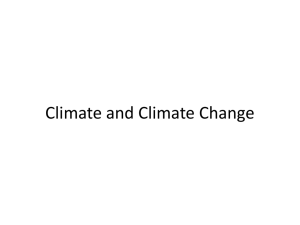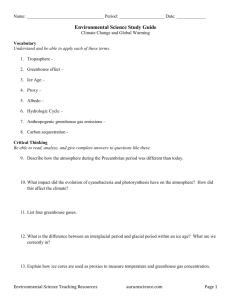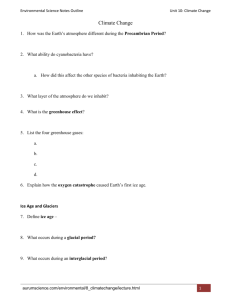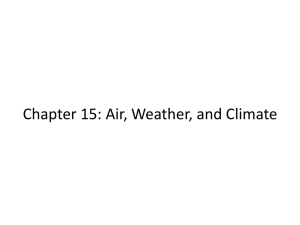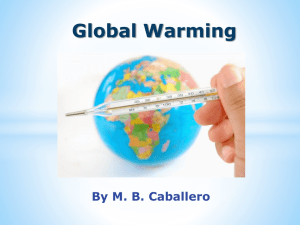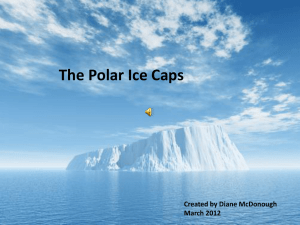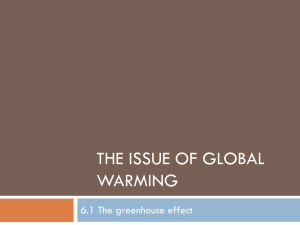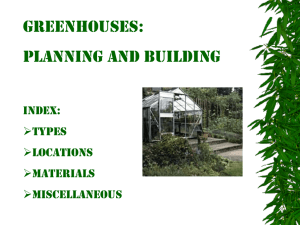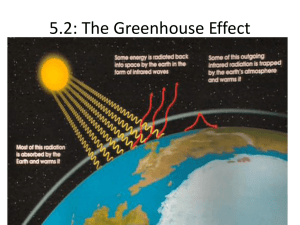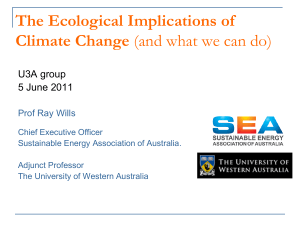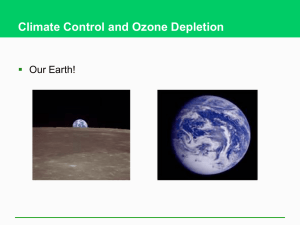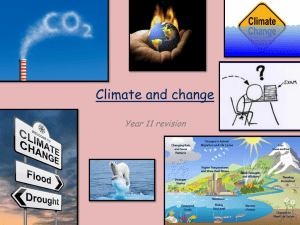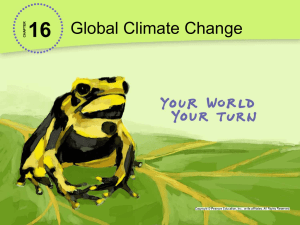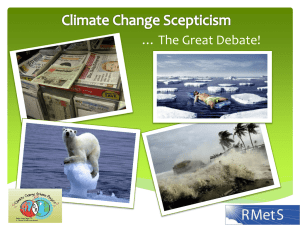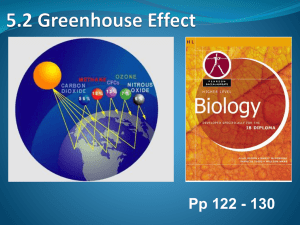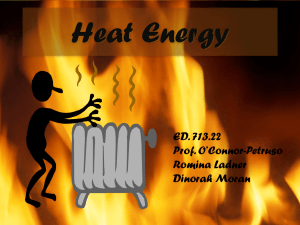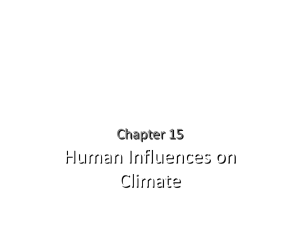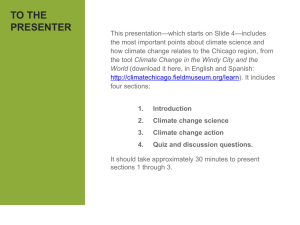Climate and Climate Change
advertisement
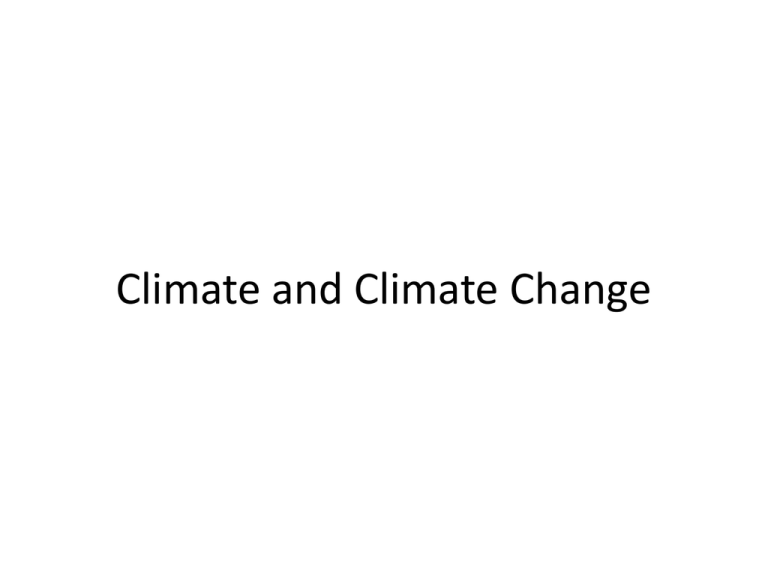
Climate and Climate Change Essential Points 1. Climate and weather prediction are completely different 2. Detecting climate change is very complex 3. The main greenhouse gas on Earth is water vapor 4. A little greenhouse effect is a good thing 5. Many things have affected earth’s past climate 6. Gradual brightening of the sun will eventually make the earth too hot for life Climate Versus Weather Climate is what you expect and weather is what you get Green Bay 1977-2002 Green Bay 1887-2002 Green Bay 1887-2002 Green Bay 1887-2002 Long-Term Trends Long-Term Trends Long-Term Trends Long-Term Trends Long-Term Trends Some Conclusions • This is not as easy as the media make it seem • The fact that it’s not easy doesn’t excuse us from dealing with it • The fact that something can’t be proven conclusively doesn’t protect you if you make the wrong decision • Don’t confuse reasoning with reality. Just because you can justify believing something doesn’t make it true. Greenhouse Effect Negative Greenhouse Effect Positive and Negative Greenhouse Effects Positive Greenhouse Effect • Light enters • IR trapped: Warming Negative Greenhouse Effect • Light Blocked • IR can leave: Cooling • Titan Greenhouse Gases • • • • • Water Vapor Carbon Dioxide Methane Nitrous and Nitric Oxides Ozone • Transparent to visible light but absorb infrared What Color is Water? What Color is Ice? Infrared Absorption Carbon Dioxide • Has doubled to 380 ppm since start of Industrial Revolution • Coupled to Temperature Rise? • More Cloud Cover? • Taken up by biomass? • Taken up by oceans? Paleoclimatology • The present is the key to the past – but • The past is also the key to the present • Study of ancient climates • Have to rely on proxy measurements • How to convert qualitative data to numbers? Ancient Paleoclimatology • • • • • Oxygen 18 Fossils Evaporites Glacial Indicators Air bubbles in amber Earth’s Climatic History • • • • • Faint Early Sun Anoxic Early Atmosphere Advent of Life – UV Protection? 2.3 b.y. Glaciation 2 b.y. Oxygen Threshold – End of Iron Formations – First Red Sandstones • 900-600 m.y. Snowball Earth Earth’s Climatic History • • • • • • • 600-500 m.y. Cambrian “Explosion” 450 m.y. Ordovician Ice Age 350 m.y. Advent of Forests 350-250 m.y. Permian Ice Age 100 m.y. Cretaceous Warm Period 50 m.y. Eocene Warm Period Pleistocene Ice Age Recent Paleoclimatology • • • • • Historic Records Tree Rings Pollen Studies Oxygen 18 Ice Cores Holocene Climate • 11,000 Younger Dryas Cooling • 9,000-6,000 Mid-Holocene Warm Period (“Climatic Optimum”) • 900-1300 AD – Medieval Warm Period • 1300-1450 Little Ice Age I • 1450-1550 Partial Recovery • 1550-1800 Little Ice Age II Possible Effects of Global Warming • • • • • • More Heat Extremes Drought Rise in Sea Level Temporary Severe Cold Spell? Rapid Migration of Ecological Zones More Biomass but Lower Nutritional Value Not a Bad Thing? • • • • Reduced Energy Demands Longer Growing Seasons More Biomass More Habitable Land What We Know and Don’t Know • Certain: Carbon Dioxide Increase • Nearly Certain: Climate is Warming • Debatable (Legitimately) – How much is of human origin? – Permanent or temporary warming? • Uncertain: – Can we do anything? – Will benefits exceed costs? – Risks of premature policy decisions? The Spectrum of Skepticism Concerns about failure to modeled features like cloud cover Too many assumptions have to be built into climate models Concerns about the way global climate data are measured How to link recent instrument data with older historical and prehistoric climate indicators? Concerns about the validity of computer modeling of climate in general Are recent climate changes man-made, or natural? Claims that warming of the climate might actually be beneficial Claims that climatic change is too far along to reverse or mitigate Claims that attempts to control climate change would be too costly Claims that human activities have no effect on climate Claims that no long term climate changes are occurring at all Claims that the earth is actually cooling Ozone Stratosphere – Good • Absorbs solar ultraviolet Troposphere – Bad • Toxic • Contributes to air pollution Ozone Depletion • Cl stripped off synthetic molecules by solar ultraviolet • Cl reacts with ozone, acts as catalyst • Cl – CF3 (Freon) • Cl – CCl3 (Carbon tetrachloride) • Cl – H (Hydrochloric Acid) 360 294 431 Smog Particulate Matter Long-Term Climatic Trends • Brightening of the Sun • Capturing of CO2 by carbonate rocks? – Extinction of plants • Moist greenhouse effect • Runaway CO2 Greenhouse Effect • Venus conditions The Ultimate Long-Term Forecast • Slow warming trend for the next billion years • Increasing humidity • Boiling and evaporation of the oceans, accompanied by extinction of life The Goldilocks Problem • Venus is too hot • Mars is too cold • Earth is J-u-st Right Planetary Habitable Zones • Primarily in the Liquid Water Zone • Ice is OK but planet can’t be too warm • Water Vapor in upper atmosphere broken down by solar UV and charged particles (photodissociation) • Hydrogen escapes to space • Can lose oceans in 100 m.y. Planetary Habitable Zones Future of Life • • • • • • • • Plants need > 10 ppm CO2 Animals and plants die around 50 C Micro-organisms can tolerate 130 C + But biology seems to like heat and we have a billion years to experiment Pressurized cells? Anti-boiling fluids? Problem is breakdown of organic molecules 200 C (380 F) max? The Oreo Model of Life History Micro-organism Earth (0-3 billion years) Multicellular Earth (3-5 billion years) Micro-organism Earth (5-6 billion years) “The white creamy middle” Essential Points 1. Climate and weather prediction are completely different 2. Detecting climate change is very complex 3. The main greenhouse gas on Earth is water vapor 4. A little greenhouse effect is a good thing 5. Many things have affected earth’s past climate 6. Gradual brightening of the sun will eventually make the earth too hot for life
